
2018 Miramichi and Cains Rivers Fall Fishing Recap
Click on any of the photos to enlarge.
Since I’m now fully retired from the 9 to 5 world, and I spent the last 5 weeks of the Atlantic salmon season at my camp on the Miramichi. I was there long enough that coming home seemed a little strange, though being back with my wife June helped ease the withdrawal symptoms. That I was salmon fishing three days ago seems a little far-fetched when I looked out into the yard here in Maine this morning and saw a Chestnut canoe that was one of two I brought home for winter refurbishing covered with a thin layer of snow.
When I got to Blackville on September 10th it was still summer, more or less. The water temps ranged from about 15C/59F in the morning, to catching a fish at a high of 22C/74F on the afternoon of September 17th. After that day, though, we didn’t have any more warm temperatures, and in fact it seemed to me the last month of the season was relatively cool. The water height was generally low. Not quite as low as 2017, but low, with the Blackville gauge reading down to .45 meters. We couldn’t run the jet canoes from Campbell’s down to Doctor’s Island, and had to drive and then wade or pole across the east channel to fish the island.
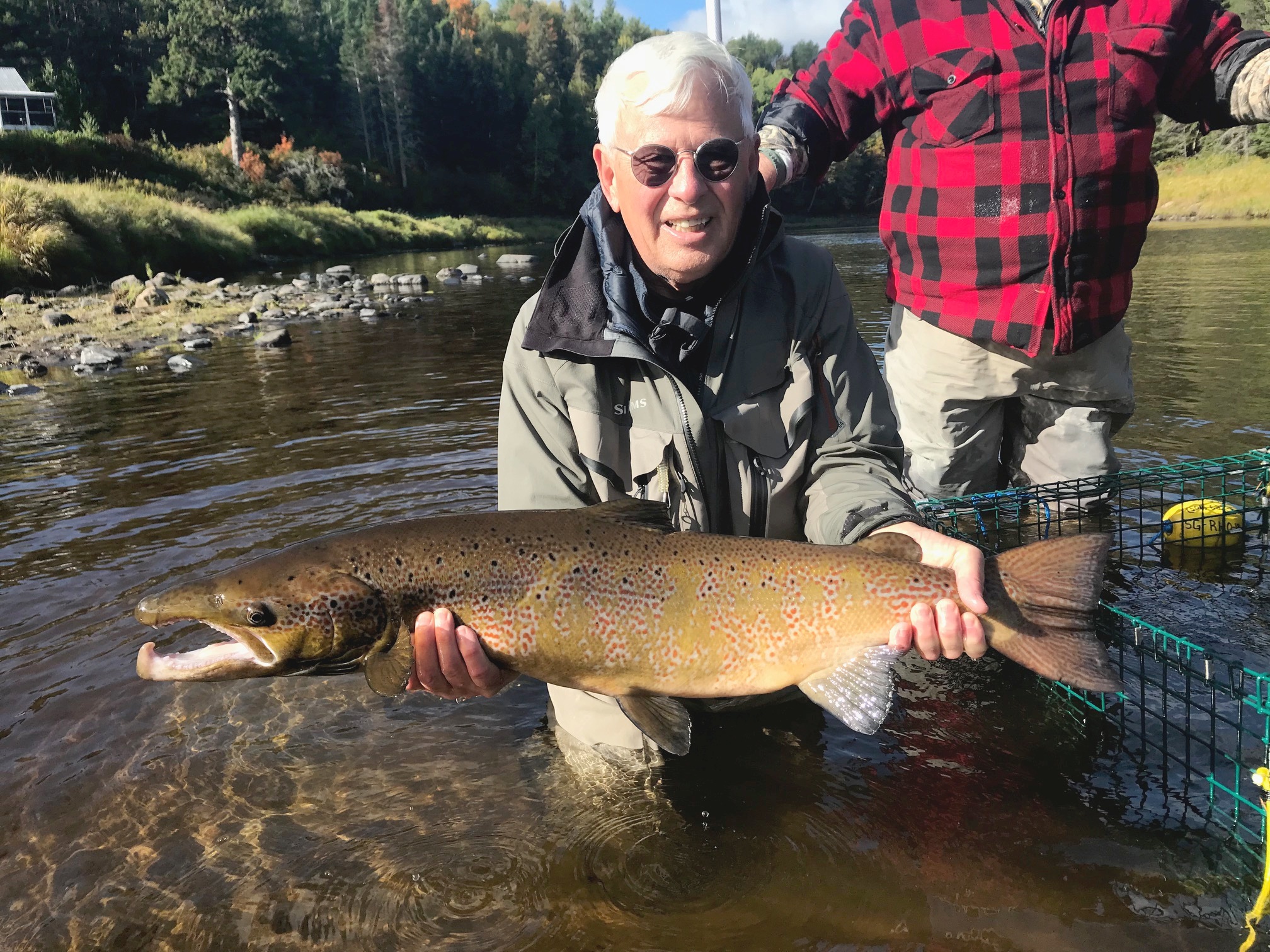
Neils Jensen with a lovely cockfish from the Cains. This fish was collected as broodstock for first feeding fry stocking.
The low water really defined the fishing during almost all of September. The month ended with a moderate raise, but that wasn’t until 9/28. Fishing, though, was okay for those on the lower river who had access to a good low-water pool. There were lots of fish in some pools on the lower Cains too, but in the low flows getting them to take was very tough. It was more or less a continuation of the summer, but with cooler water. In early September many of the Miramichi lodges upriver of the mouth of the Cains really struggled to even see a fish. I spoke with Keith Wilson about their success upriver in McNamee, and he said that the last three weeks of the season were very good.
Our catches during all but the last couple of days of September were on summer flies. We used things like #10 Black Bears, needle-thin Sneakies, and bombers – quite a few on bombers.
Interestingly, and different than last fall – at least for us – we got our largest fish during the early, low water period. Jim Graul and Steve Hobson had a 20 and an 18 respectively along with some smaller fish on the 11th. During the next four weeks the largest we caught was estimated at 15 pounds. Fishing was okay by modern standards, hooking two or three salmon most days with an average of 3 anglers in camp, but there just weren’t any big days.
About 55% of the fish we landed were salmon. A lot of conservation concerns are now centered around what is happening to our salmon in that first year at sea. For salmon returns to eclipse grilse returns by a very large margin – which was the case in 2018 – is essentially unprecedented in Miramichi salmon history. Salmon numbers are bolstered by repeat spawners, and it certainly appears that after the first year the salmon are much better able to cope with whatever they are struggling against in the sea.
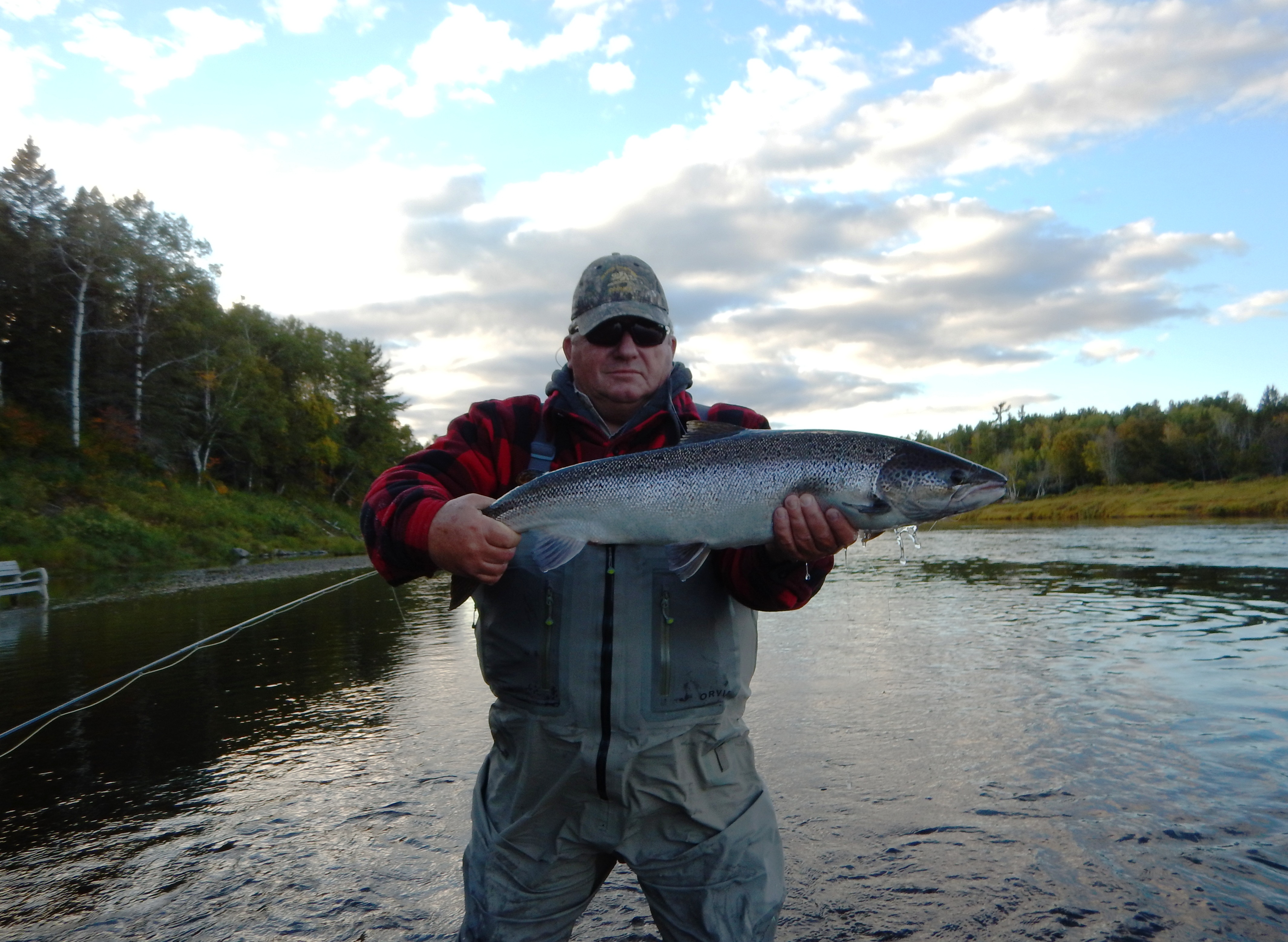
Darrell Warren holds a nice salmon from Keenan’s Pool. Fishing here was much better after the small late September raise.
On September 27th the Miramichi got about an inch of rain in the headwaters. The Cains got very little by comparison. Correspondingly the Miramichi rose a good foot and a half while the Cains hardly budged. The main river fishing at Campbell’s and Keenan’s as well as Doctor’s Island was the best then that we had during September and October, and for a couple of days we averaged a fish in the net per rod each day. While this is not fantastic fishing by historic standards it was the best we had seen since the August opening of the cold water pools that hadn’t been fished for weeks – scroll back to August blog for more on that. Many of these were running fish, and therefore were not hooked as well. One evening at Doctor’s Island, one of my guests, an excellent and very experienced salmon fisherman, lost 5 good fish in a row that simply came unhooked early in the fight. Three days later the gauge was back under .7 meters, and fishing slowed up noticeably.
When it comes to October the attention at my camp turns to the Cains. Given anything more than very low water, but less than a major raise of water, the run seems to start moving up the Cains River from the summer holding areas of Salmon Brook and below during the second half of September. The process is quite gradual. If we get a large raise of water, though, everything can change, and many of the salmon seem to go from the lower river right up into the headwaters in one big surge. It did seem that although we caught a salmon at Brophy Pool on 10/2, the numbers of fish in residence were many less than just a week earlier. In spite of this exodus reports of fish being caught further upriver were not being heard very loudly. There is a lot of river there, and the fish were taking their time moving up. The question is always whether or not we will be able to enjoy any fishing 20 more miles upriver at Mahoney Brook. It was looking unlikely, with water as low as .52 meters as late as 10/9.
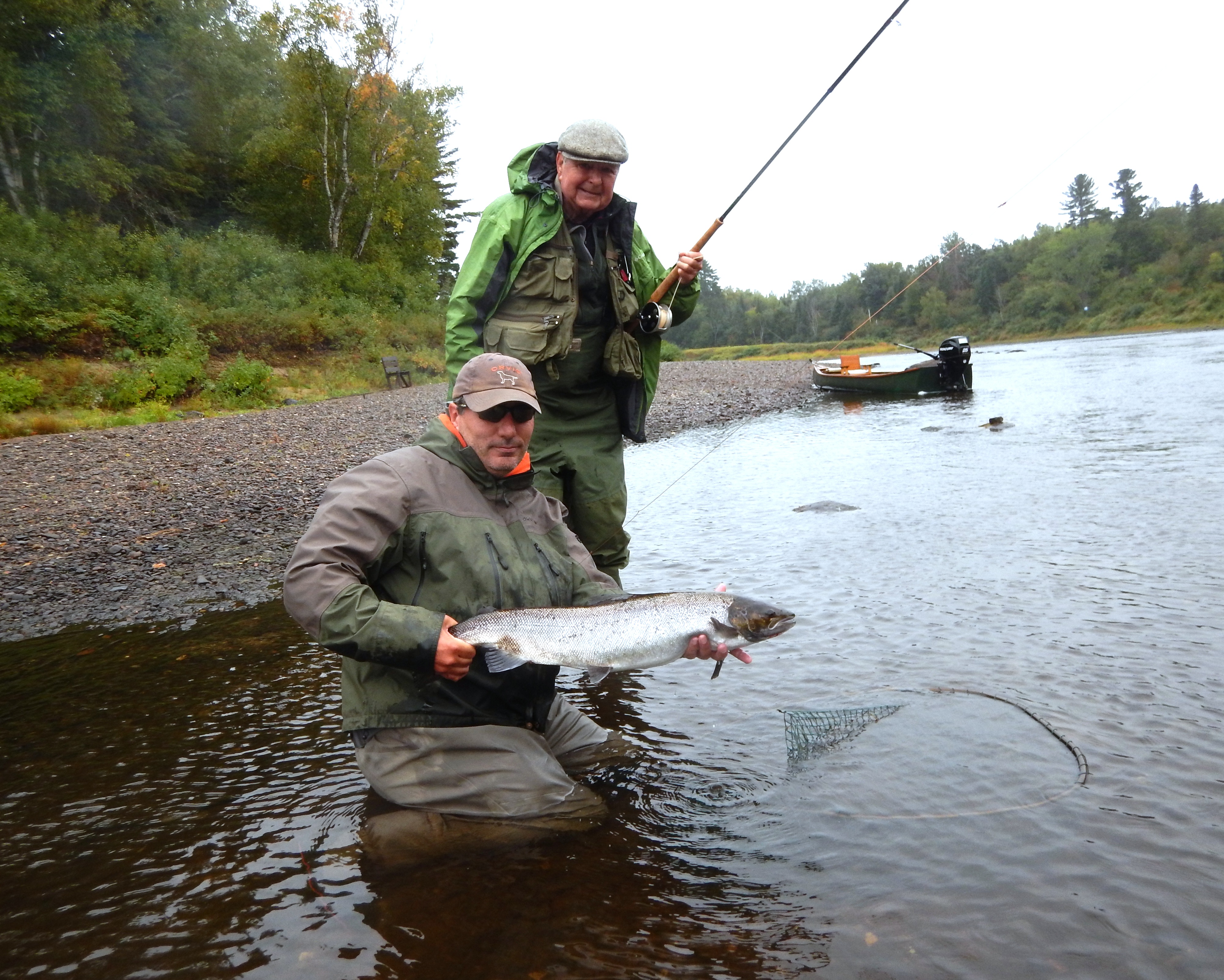
Jason Curtis holds a very fresh late-season salmon caught by angler Jerry Robinson. This was a twin of another that he got that morning.
Miraculously, the forecast of showers made earlier in the week morphed into significant rain, and on 10/11 the water began to rise. We got to Doctor’s Island that morning at around 7:30, and a few minutes later I saw a fish roll in the bottom of the pool. We saw perhaps a dozen fish roll or jump in various areas of the pool until about 9:30 when things became quiet again. I landed what would be our last Doctor’s Island salmon during rising water using a sink tip line and a #2 October Killer streamer fly, and a friend lost a fish on a similar rig. We also had a number of short strikes or “pulls.” This wasn’t a big catch by any measure, but these were running fish on rising water, and fish in that travel mode usually don’t take well if at all. We all got the feeling that we were looking at the tip of an iceberg. Beginning around 9:30 and running right until after 11:00 or so what must have been this same school passed through Campbell’s and Keenan’s Pools about 4 miles upriver. They saw more fish jumping than we had below, but they didn’t manage to land any of them.
The fish that I caught was tagged, and we e-mailed DFO staff at Millerton who confirmed that the fish had been tagged there on Monday, three days before. With water rapidly rising towards an eventual peak of 1.7 meters we were all highly optimistic, but we had another lesson or two to learn this year from the Miramichi.
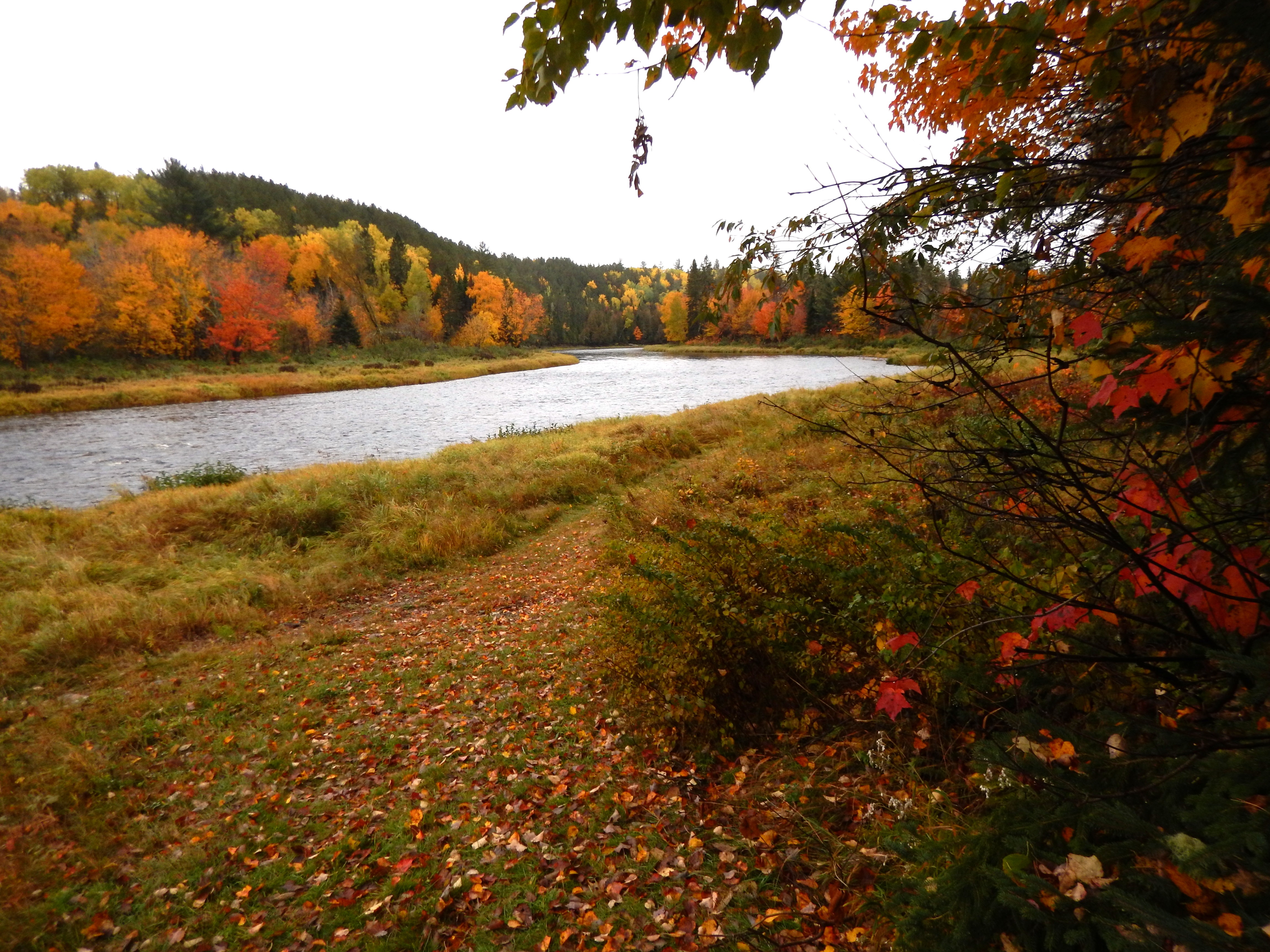
Looking upriver from the run at Mahoney Brook. I would never get to see this view enough if I lived to be 200.
I was in contact with Byron Coughlin of Country Haven, and in the days just before this last raise they started to see and catch salmon in the Moore Pool just above Shinnickburn. This is about 18 miles above the mouth. Usually a day or two after we hear of them at the Moore Pool we find them in the waters around Mahoney Brook, so we started making daily trips. These trips are always a bit of an adventure. First, the camp is relatively remote, and the mornings in October are often very cold. In this country that often spells moose, and on our first morning in I saw three in one group at the top of a hill, then a big bull less than a half mile further on. We saw moose every day we went up, and one day I was fishing the home pool at Mahoney Brook when I heard what sounded like someone hitting rocks underwater with a sledge hammer. I turned and looked up stream to see a big bull moose about 500 feet away trudging across the river. I could clearly hear his hooves hit the river bottom with every step. It had taken me about three minutes to carefully wade across that pool, and he ambled across in about 20 seconds.
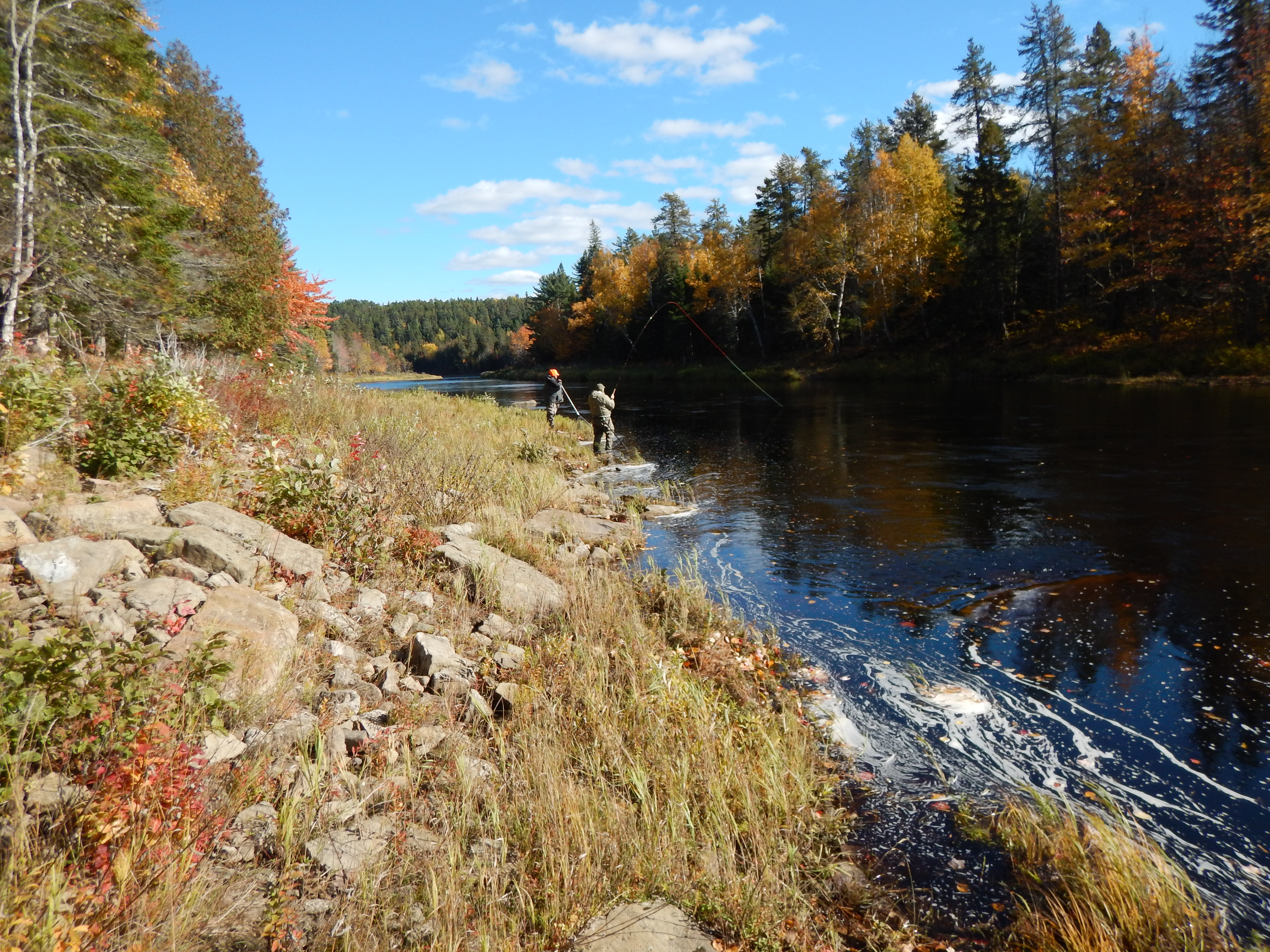
Bill Utley fighting salmon with Darrell Warren waiting with the net at the Wood’s Pool on the Cains.
On 10/12 the Cains was rising rapidly. Unlike the main river the Cains peaks fairly quickly, and drops down enough to clear up almost immediately. We fished on 10/12 but it was very dirty and still rising. On 10/13 it was still high, but fairly clear. We saw one fish jump near the camp, but we caught nothing. On 10/14 the Cains was dropping back nicely and we caught two teen-sized salmon and had some other interest in our flies. Both the fish we caught had sea lice, so they weren’t fish that had been holding in the lower Cains, they were fresh in from the estuary. On the last day we fished hard up and down river from the Mahoney Brook camp, but the only action we had was raising one fish that hit the fly but failed to become hooked. It seemed likely to me that the great many Cains River fish that had been holding between Black Brook and Sabbies River just blew right by us on that raise. Keith said that he felt a lot of fish ran up to the Cains headwaters to spawn on that big raise, but as was our experience 35 miles downriver from there it wasn’t easy to get these determined fish to stop and take a fly. He will have a much better idea when the fish start making redds on the gravel bars in another couple of weeks. Keith will fill us in on that, and I’ll be headed back up to Mahoney Brook in early November to hang out for a few days. I’ll get a report out after that regarding any spawning activity that I see or hear about.
My friend Bill Utley caught one of the sea-liced, Mahoney Brook salmon, but what is more noteworthy than the catch itself is that he caught it on a Herman’s Choice Cains River streamer. Bill tied all the flies for my upcoming book On the Cains: Atlantic Salmon and Sea-Run Brook Trout on the Miramichi’s Greatest Tributary. The Cains River streamers date back to the beginning of sport fishing on the Miramichi and Cains Rivers when one of outfitter Harry Allen’s sports snagged some long grass on a back cast and launched it into a pool full of reluctant salmon – or so the story is told – and then it was immediately taken by a big salmon. Harry went back to his farm and tied a few of what became known as Allen’s Streamer with some long hackles that he pulled from one of his roosters. Later Oscar Weber of the Weber Tackle Company made the series famous. Many of flies were named for Harry Allen and his guides, though I don’t know who Herman was. There was, for instance, a Wade’s Choice streamer named for Allen’s young guide Charlie Wade who went on to be the most famous name in Miramichi salmon fishing as the founder of Wade’s Fishing Lodge. It was great to see a nice fish taken on a 100 year old pattern designed originally for the Cains River.
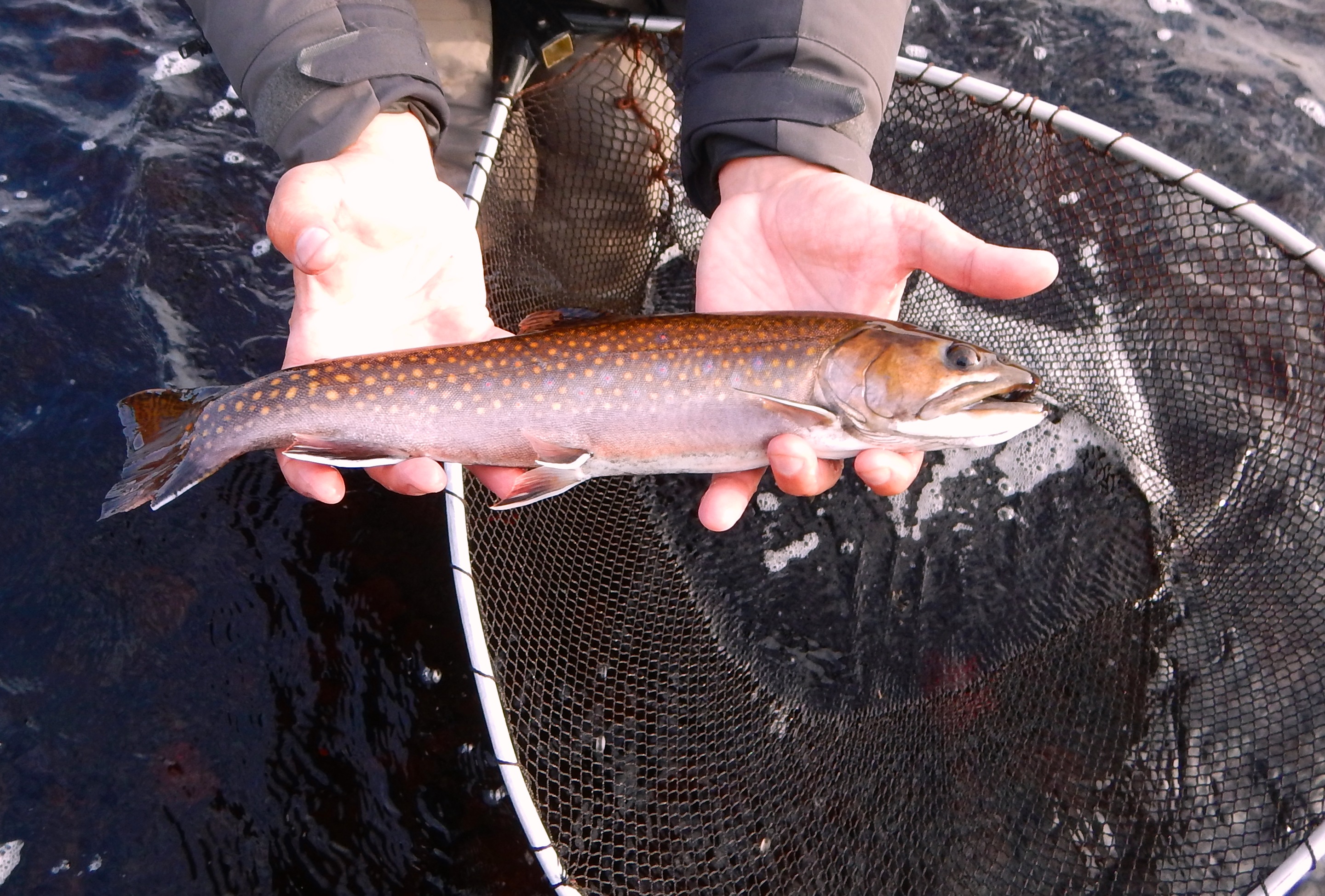
Cains River brook trout. The decrease in their abundance in just 5 or 6 years is astounding. What a beautiful creature.
Keith did add that during the time they should be there that they were not seeing any big brook trout in the normal spawning areas. As with Atlantic salmon, smelts, and gasperaux it seems as if the brookie population has been headed in the exact opposite direction than striped bass down in the estuary. It can’t possibly be coincidental. I did get what now stands for a decent brook trout of about 16 inches along with a couple of smaller ones at Mahoney Brook during the last couple days of the season. The larger fish hit so hard that I thought it was a grilse for a while. Just 6 or 7 years ago there were so many brookies in the run in front of the camp that they were almost a nuisance during the October fishing. I’ll report more on how the First Nations commercial fishery for striped bass is going later in the fall, and I will have full wrap up of the Miramichi trap numbers and estimated size of the run. I can tell you that as of 10/15 salmon numbers were up substantially over last year, but grilse numbers were way down from what was already a very low number.
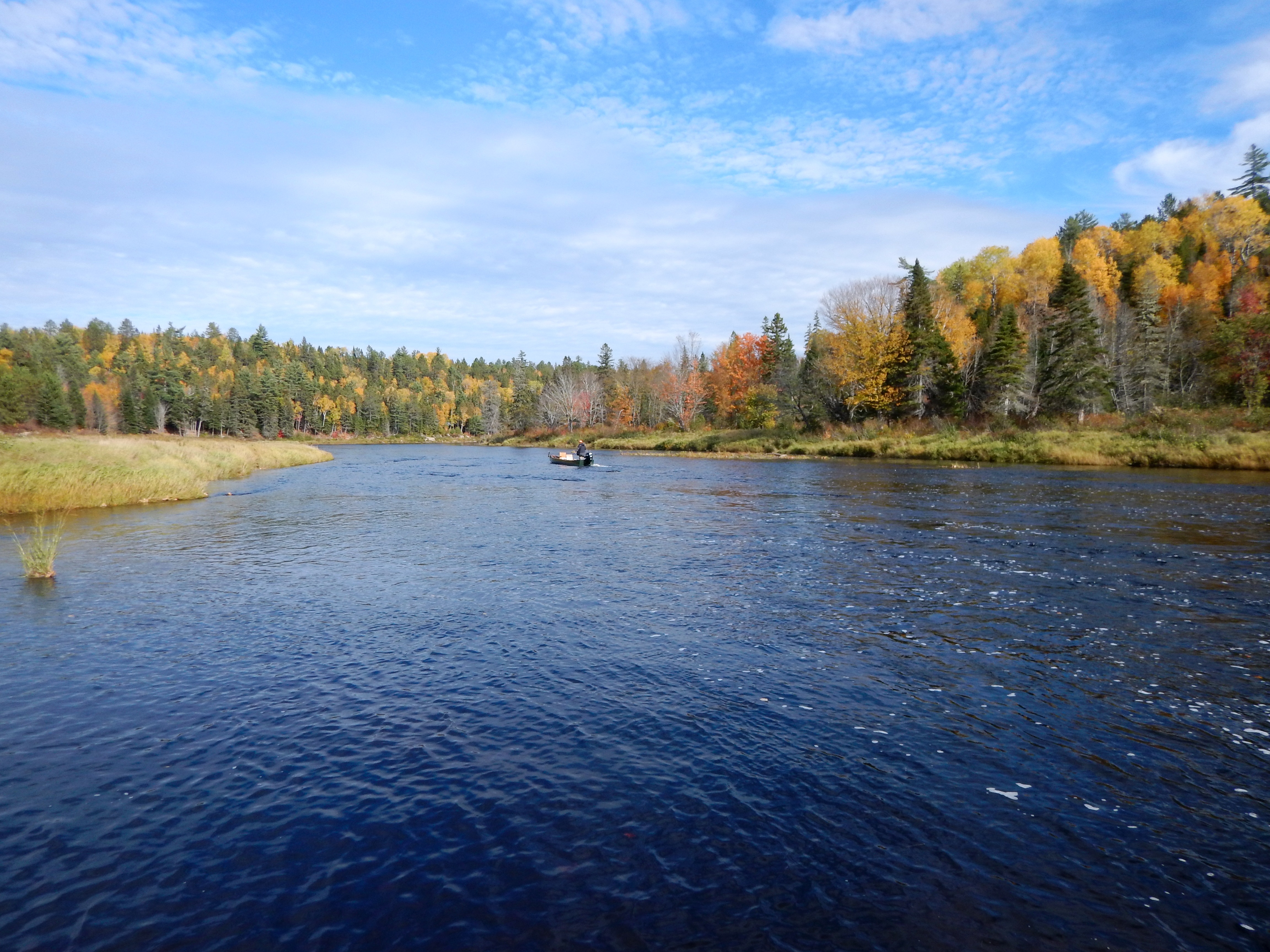
Head guide Jason Curtis heading down the Cains River at 3:00 PM 10/15 for the 22 mile ride to Campbell’s Pool. The season is over.
Brad Burns


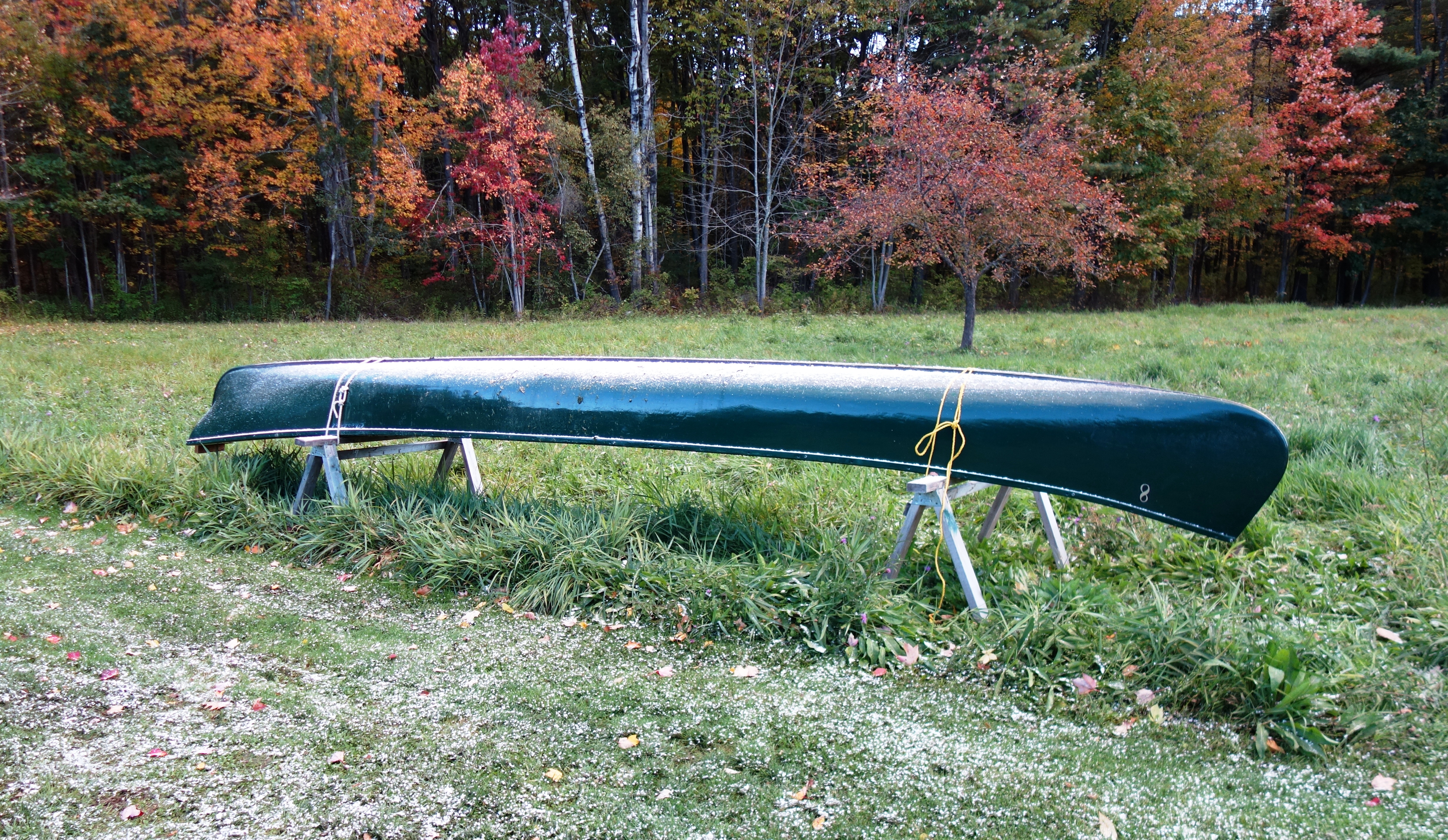
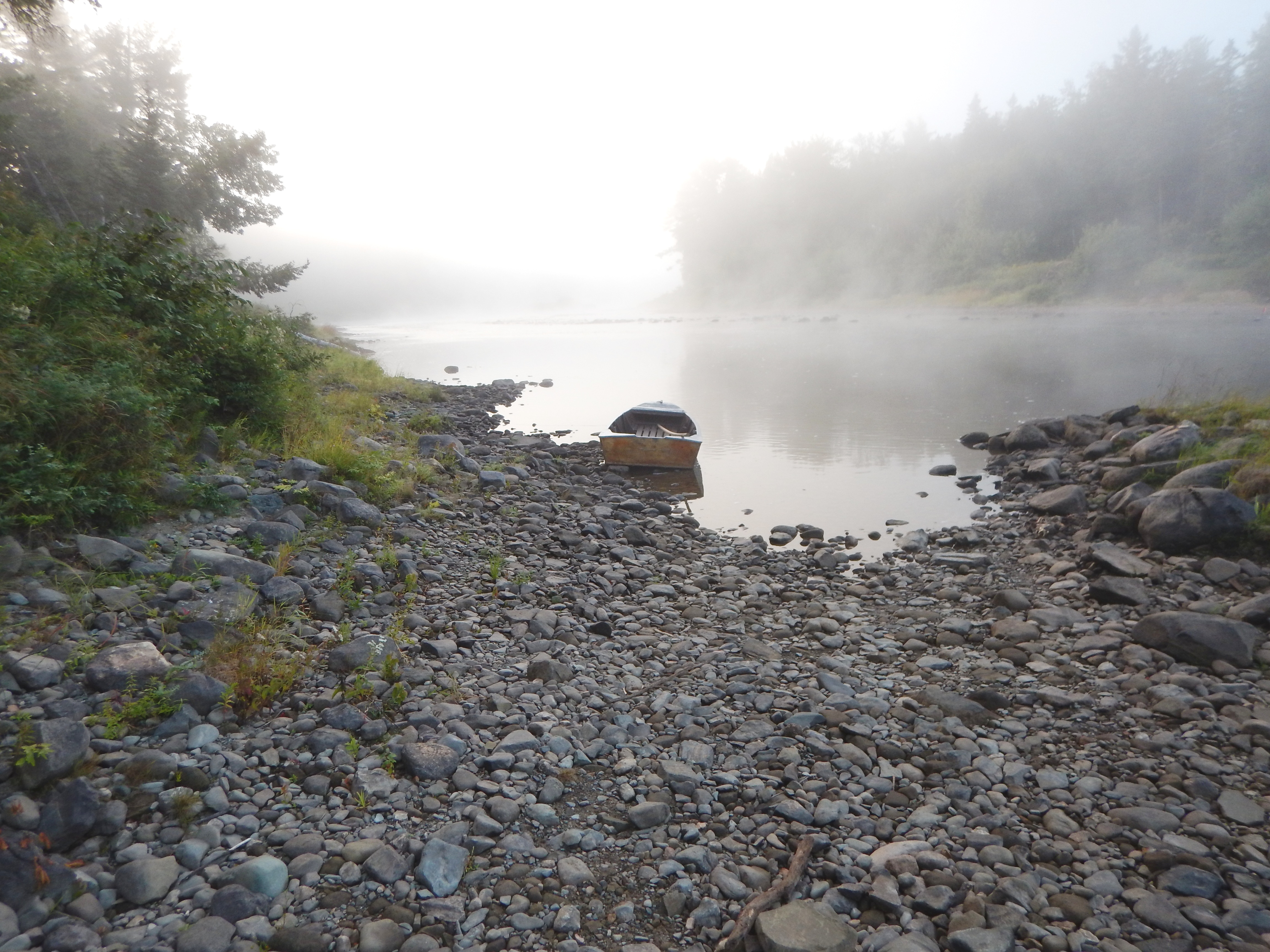
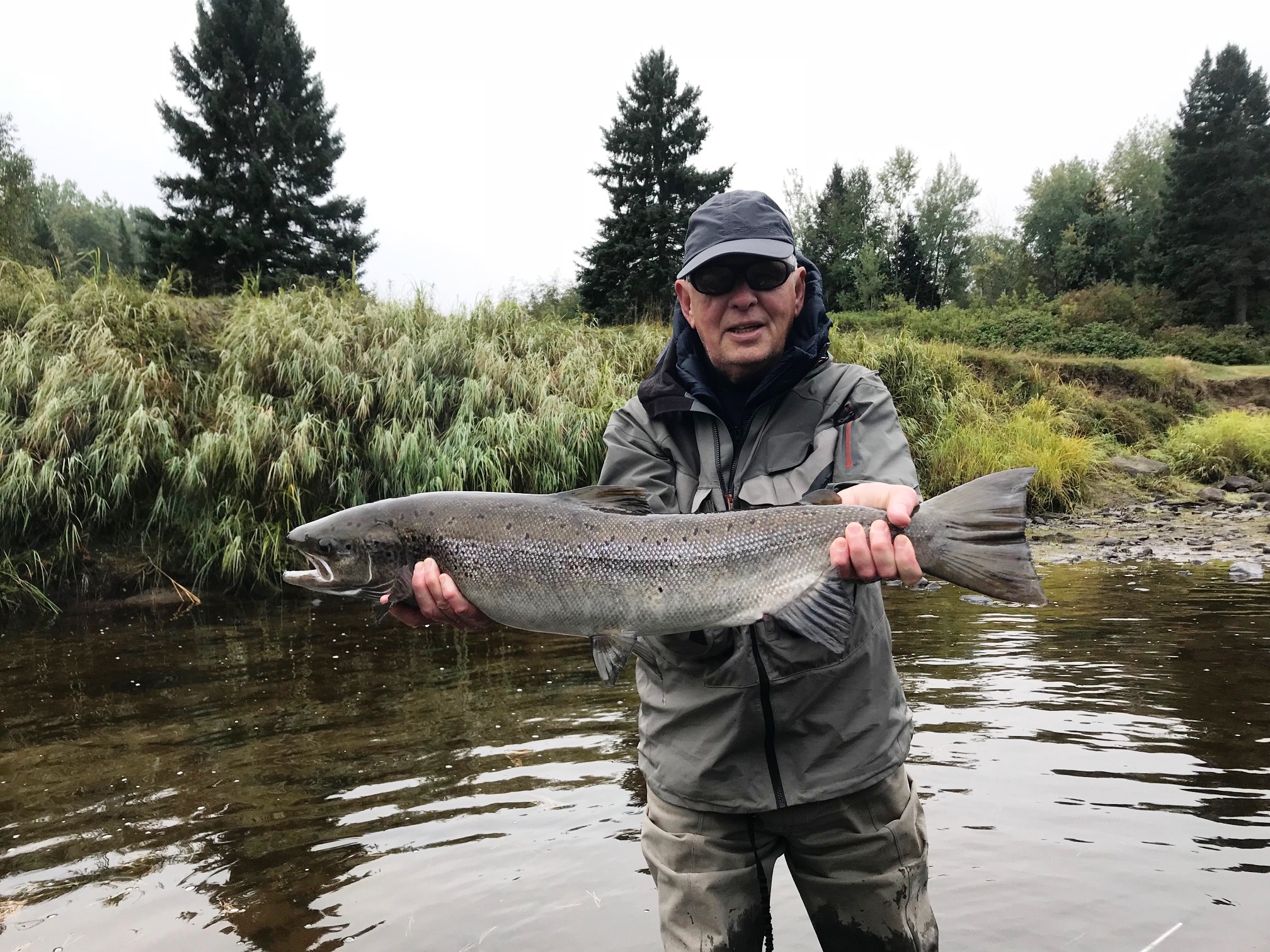
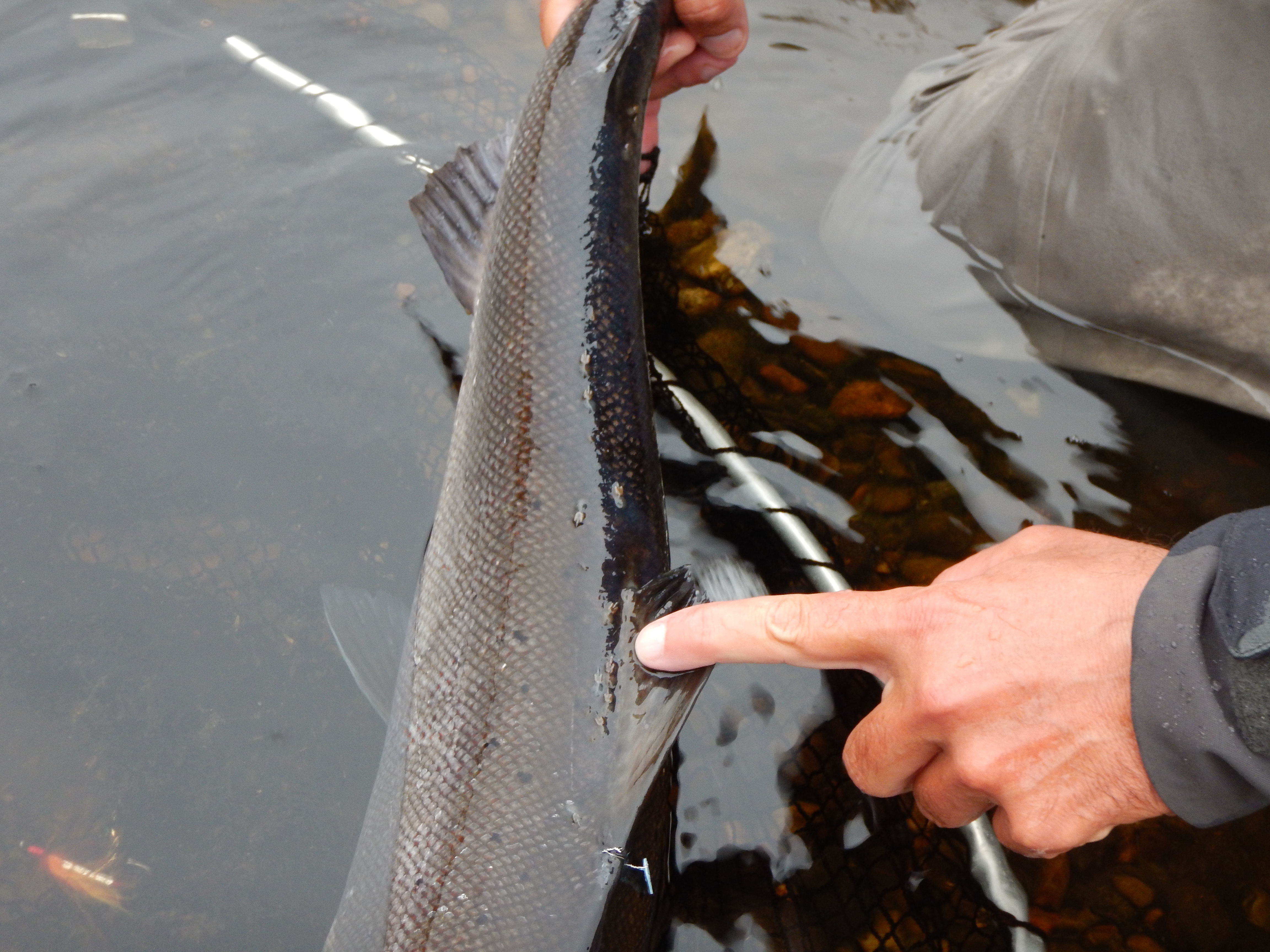
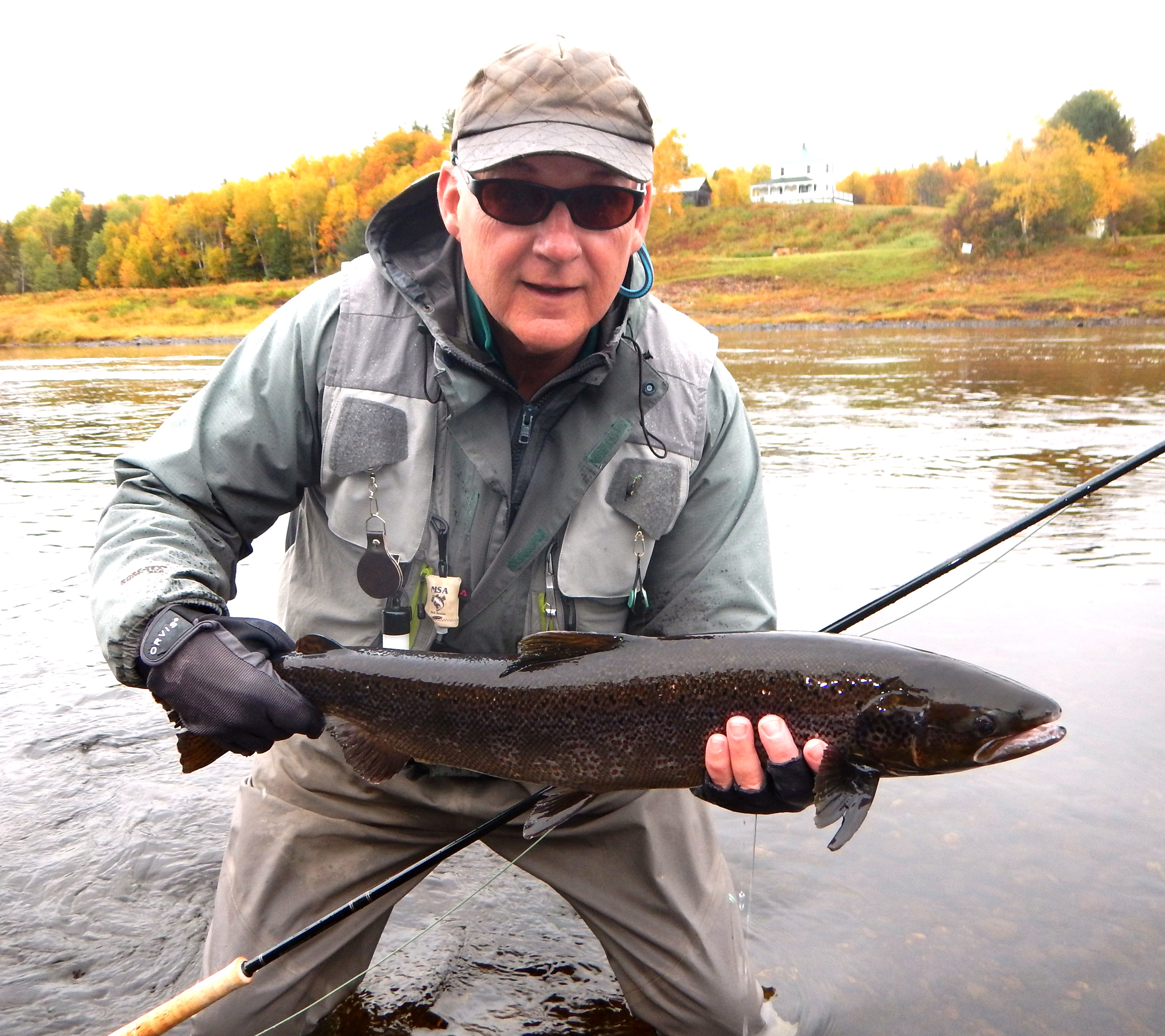
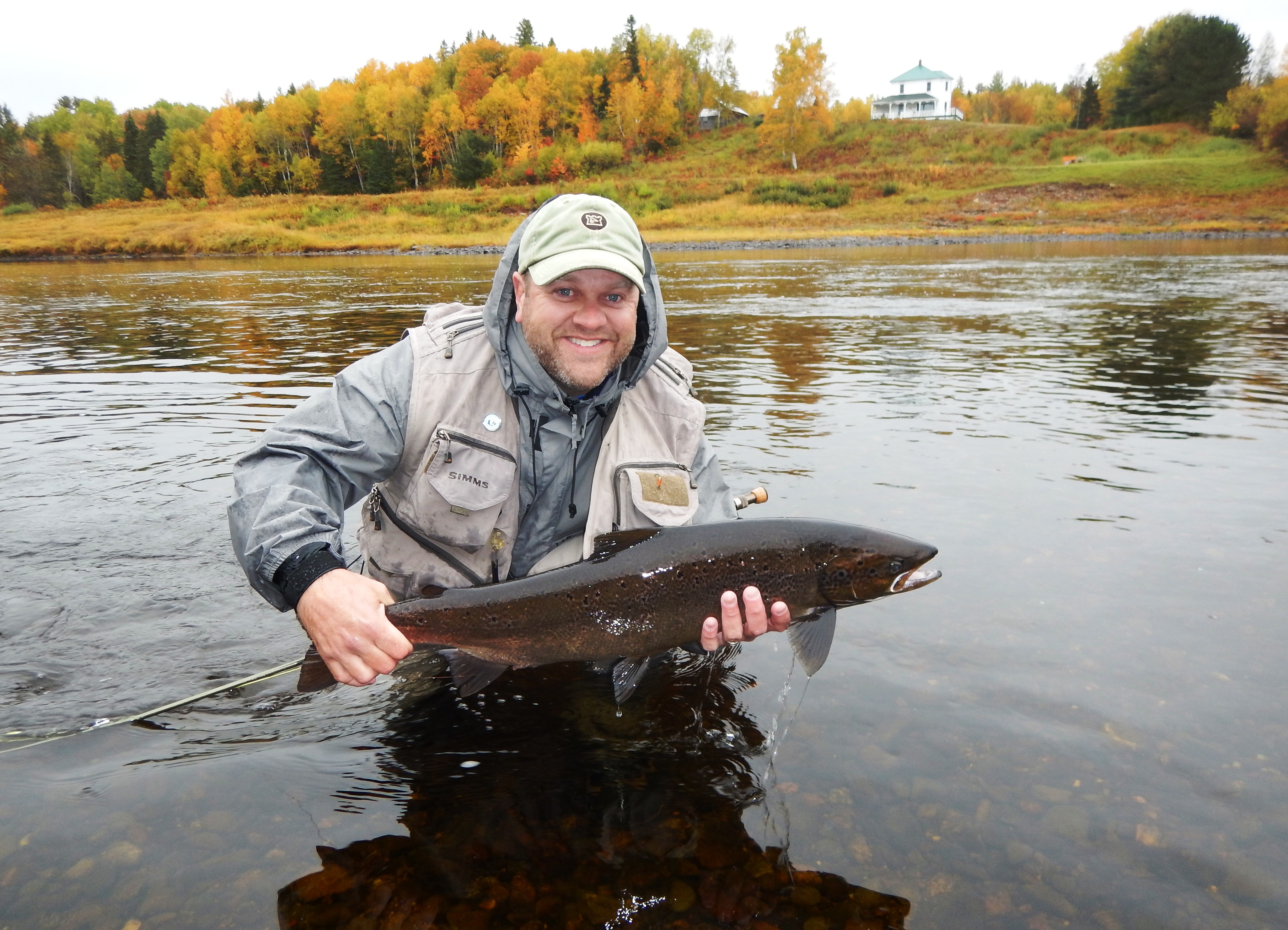
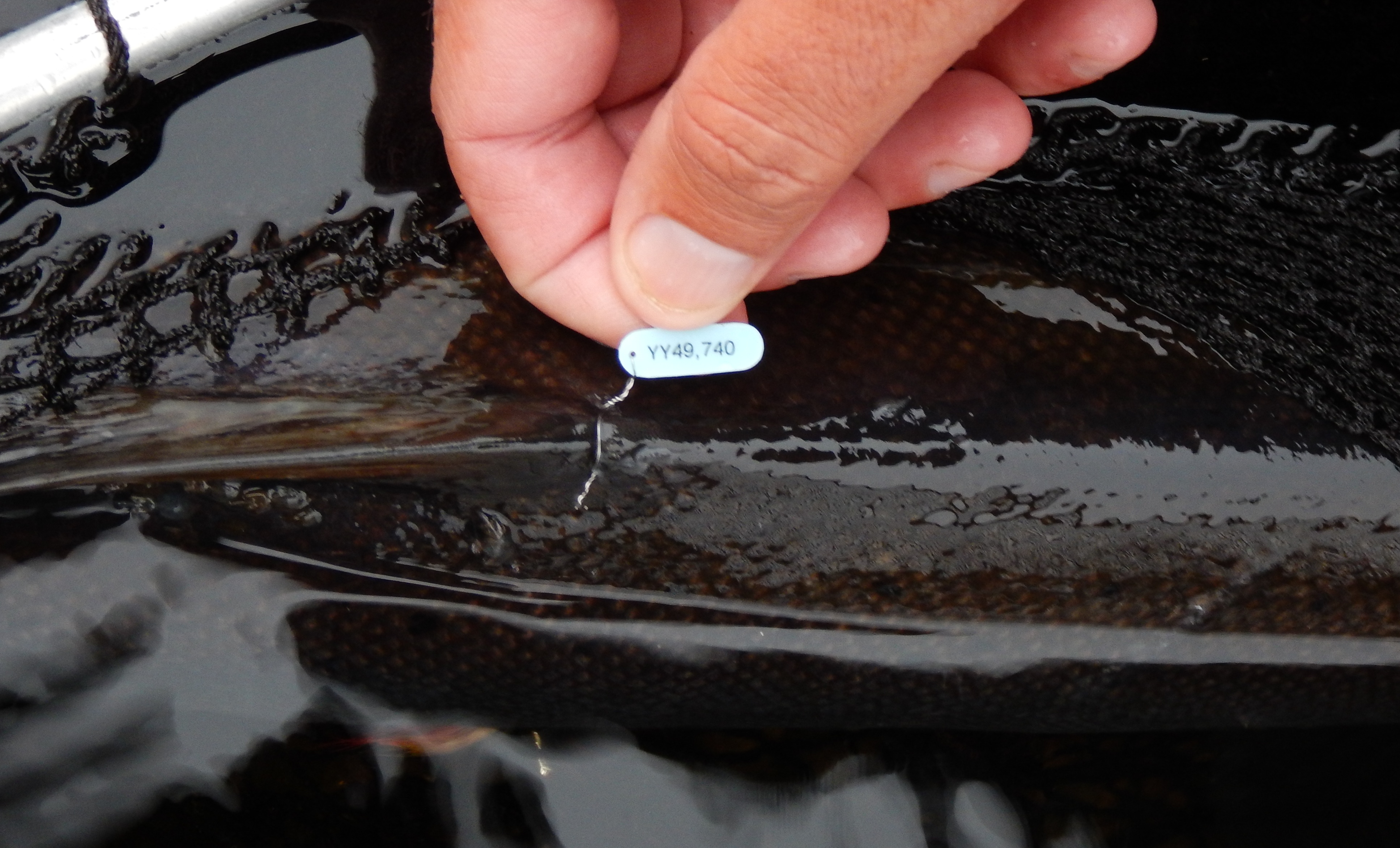
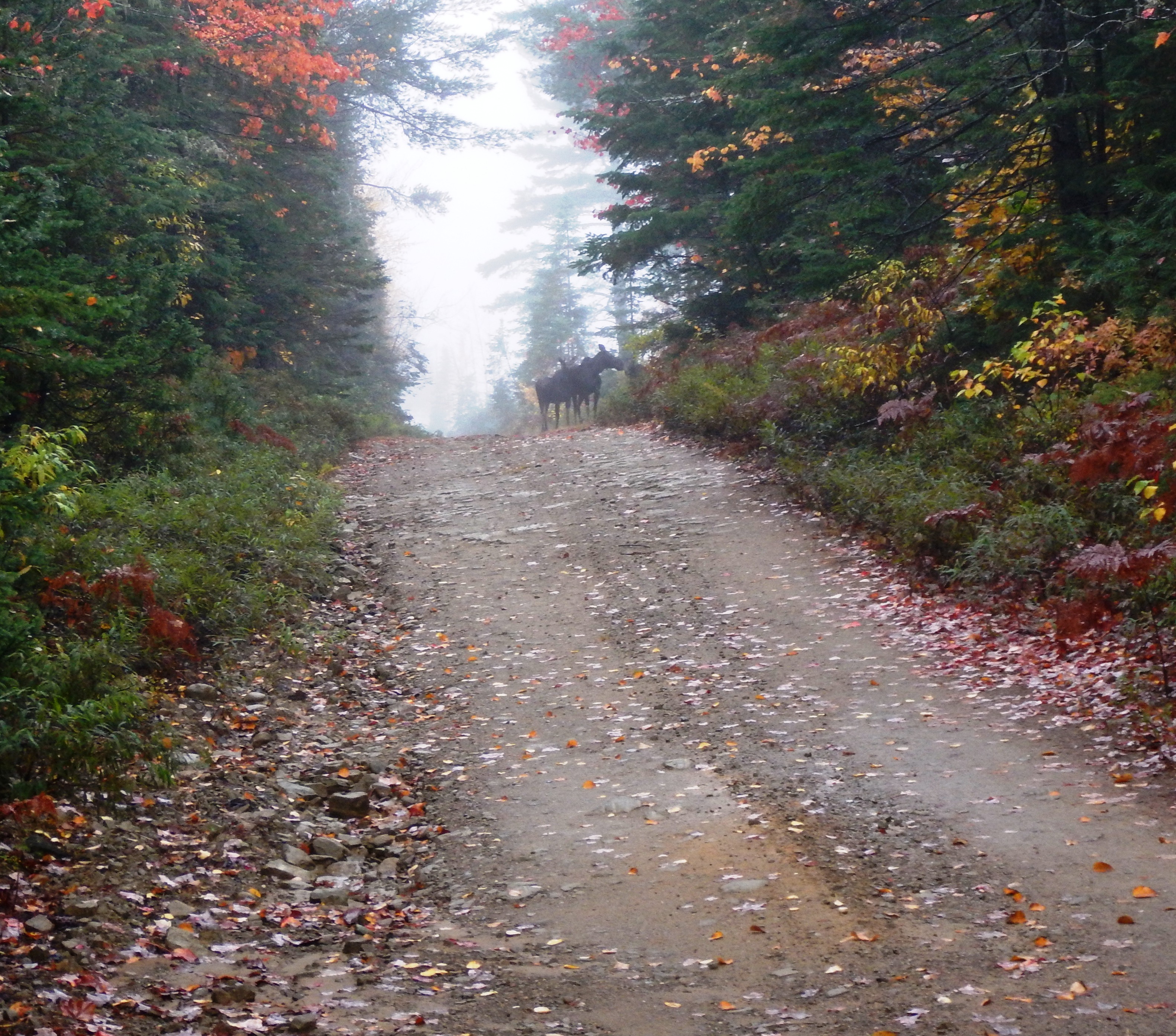
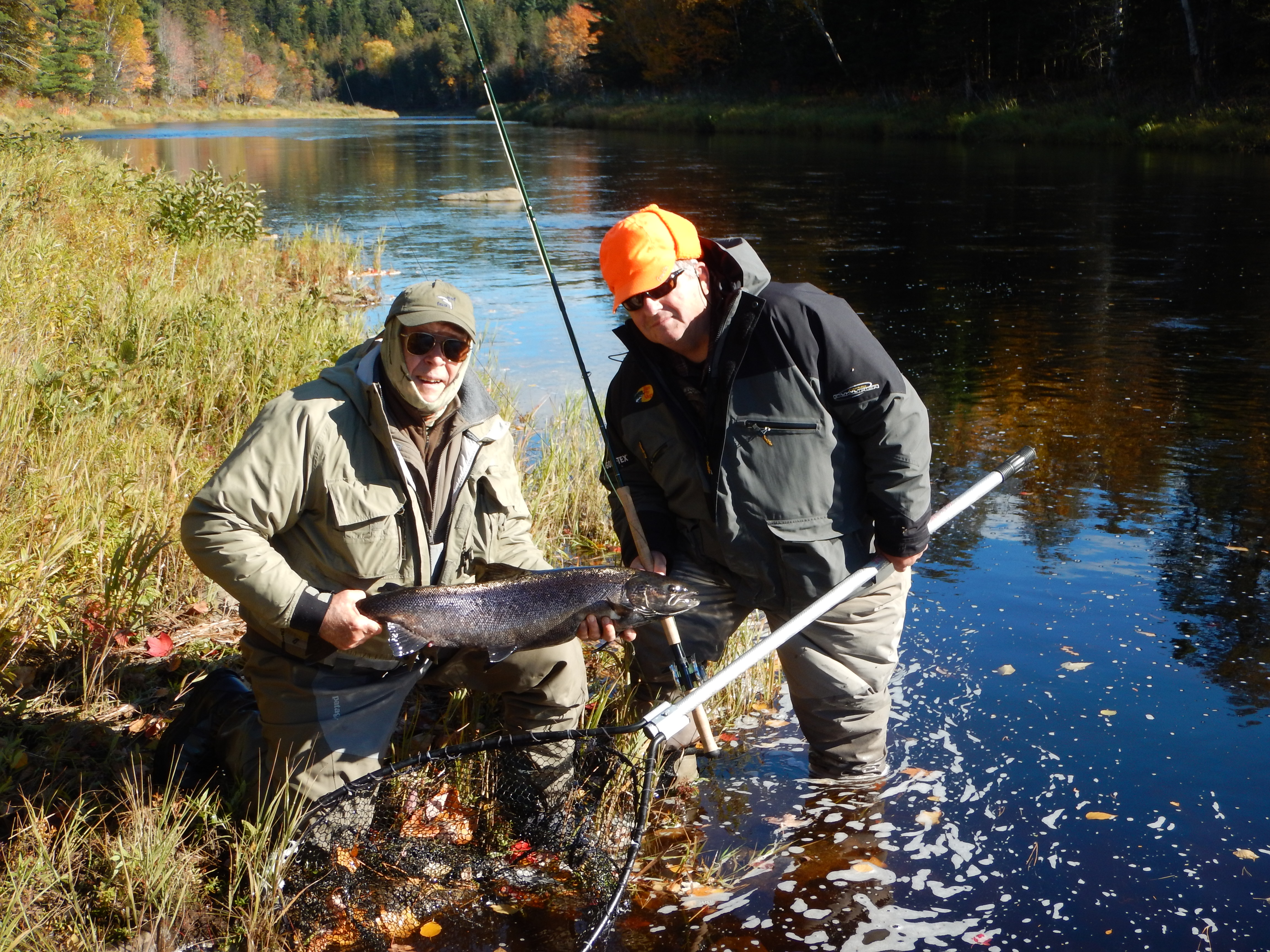
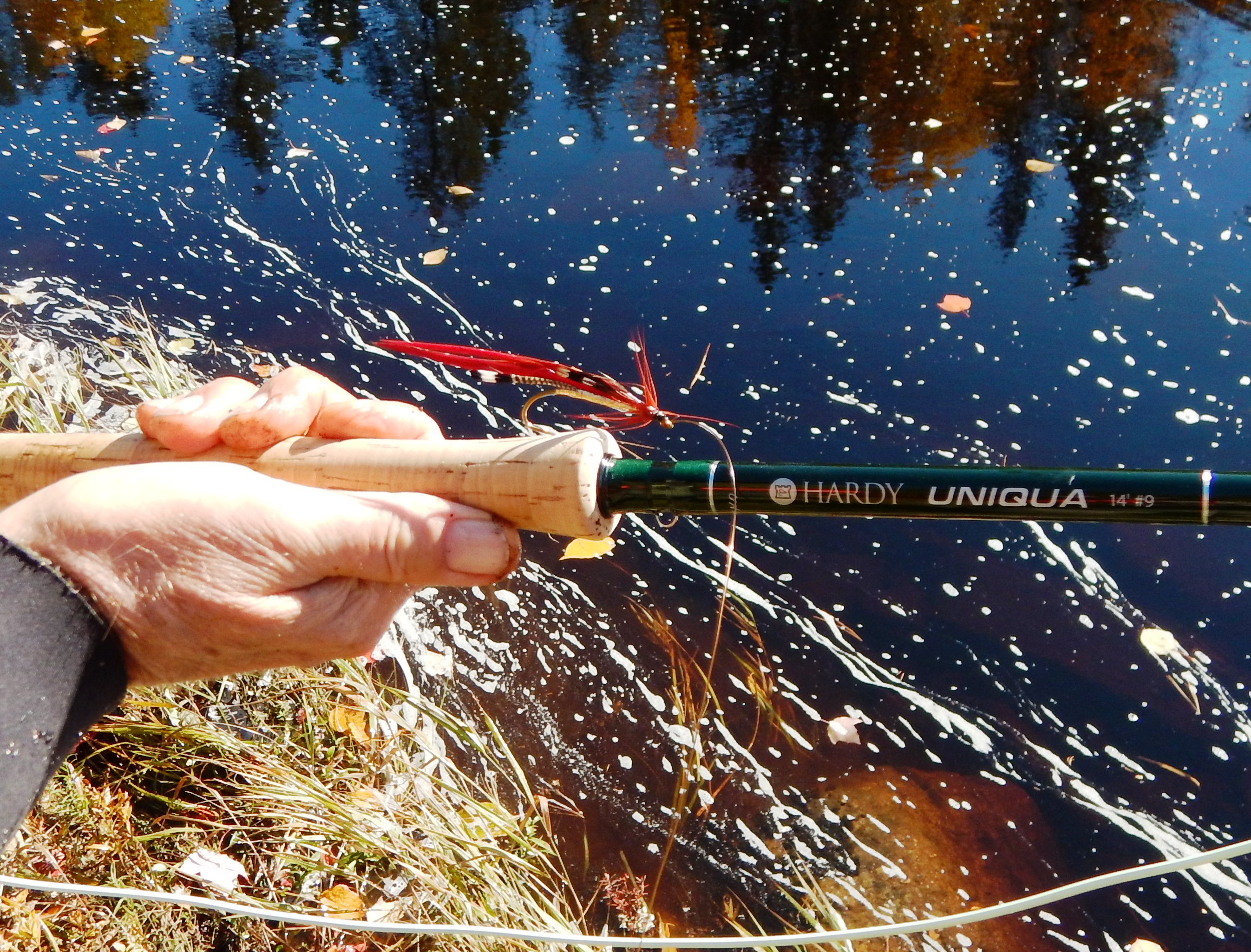
Hi Brad- Despite the water levels leading into the fall we finished up the last three weeks on the Miramichi with surprisingly decent results. The big rise in water near the end was much needed for the salmon of course but hook-ups were fewer. It was nice to see some good sized MSW salmon too. The water on the upper Cains was ideal for moving salmon up the system but anglers did not have much success. I am looking forward to seeing what shows up on the spawning redds over the next several weeks. Unfortunately all the traditional spawning locations for our beloved sea-run brook trout appear to be completely void of any spawning trout. Thanks for your reports. Regards, Keith
Hi Brad, Great report!! I spent 9 days at Bullock’s Lodge the last week of September. We arrived the 22nd to a river that was at summer lows with only 2 of the 4 pools fishable due to lack of flow. I had 3 in my party, all experience salmon anglers, and 3 other guests were in the camp from the week before. They like myself were long time Bullock’s customers who started when Vince Swazy was running it as Tuckaway Camps. No fish were hooked or seen by that group the week prior to our arrival and we had the same experience thru the 26th when the 3 other guests left. We did land 2 small dark grilse on the 26th but had no other action. With the rain of the 27th we had a healthy rise of 18″ and all were excited about the possibility of new fish moving in. BTW your daily posts on the Salmon Blog were keeping our spirits up but unfortunately fishing continued to be non-existent for the next couple of days and by Sunday the 30th we were back to the same water levels when we arrived. A few fish were hooked Sunday night but then nothing thru the 2nd when we left. I went from the river up to Cape Breton on a touring trip with my wife who flew in to Fredricton on 10/2 and while I didn’t fish I did stay an Inn next to the Margaree. Several fishermen from Pa. were fishing the Margaree and they were having exceptional luck. On October 6th one fellow landed 3 salmon from 14 lbs to one 42″ long in the 30lb class. Somehow I feel that the up river fishing on the Miramichi is deteriorating a faster pace than it is down river. In 2016 our luck was not great but we saw good numbers of fish. I remember my last day that year fishing with Bill Tomiello and counting over 100 fish that showed in home pool from 5pm til dark. Last year I notice way fewer fish and this year I’m gonna say at times their were none on the best pools. Very discouraging to fish an empty pool! Hopefully it’s more a function of the drought than the Stripers but I’ll be back with bells on next year in the end of May doing my part to lower the Striper population assuming DFO complies with less stringent catch limits. How about you?
William – ughh…sounds very tough. I feel badly for everyone involved. It is getting very hard to make sense out of DFO’s positions. There are problems on all rivers with winter sea survival, but the Miramichi is home to an enormous striper population that fills the estuary with a million hungry fish at the same time the smolts come downriver. In spite of this the DFO still has in place a very restrictive set of bag and size limit regulations. They are also blocking the CAST program from trying to help the salmon by stocking adult salmon – raised from wild smolts – into the river. It feels like they just hate salmon and salmon fisherman, but I can’t imagine that is actually true.
Thanks Keith. We’ll look forward to your report on the spawning activity in the Cains headwaters in a few weeks. Brad
Hi Brad, thank you for this comprehensive end-of-season report. I also appreciated reading your almost-daily reports over the past several weeks. I still feel the frustration of losing a nice salmon in September at Brophy shortly after hookup, but your report of someone losing 5 in one session put things into perspective for me. I don’t drink Scotch, but I might have started if it had happened to me. It always feels a bit melancholy when October 15th comes and goes, but now all we can do is look forward to 2019, and hope for one of those magical moments on the river when conditions are perfect and the salmon are all in a cooperative taking mood.
When I would have a streak of extreme bad luck at losing salmon my old mentor Willy Bacso would say that “they just weren’t taking well.” I think that in many cases he was right. A salmon can come up off its lie and take your fly in a nice turn that hooks it right in the scissors, and you’ll seldom lose one of those. Salmon can also be on the move and just come up behind your fly and hit it. You may hook them in the tip of the mouth, but there is a good chance that the hook will not hold.
Sadly, I must agree with Brad and Keith about the decimated sea-run stock on the Cains. This has always been a great place to catch and release the big brookies but this year was the worst I have ever seen. I fished the pools that have always held sea-runs a half-dozen times throughout the season and never saw any sign of a normal run. I gather that others who usually fish the Cains had similar experiences as the Crown reserves were unbooked almost every day, a sign that fishing was so poor no one was fishing the lower or upper stretches.
The last day of the season I fished Wildcat and the pools above and there were neither salmon nor sea trout to be seen. You can always hope this year has been an aberration but experience tells us that once a stock shows this much of a decline the trend is not easily reversed.
One part of the solution should be to increase stocking of the river, which I also believe should also be done for Atlantic salmon throughout the Miramichi watershed. The amount of stocking taking place in NB is minuscule. This would be a good place to spend the money that is generated each year from our licence sales and the Conservation licence plates. The money from the plates, which is substantial, now goes to a wide variety of well-meaning but somewhat obscure programs and ventures.
As anglers, we should be telling government that the stocking program in our province does not come close to meeting the actual needs.
Steven – the CAST organization made up of the University of New Brunswick, Irving, the Miramichi Salmon Association and others – see their website “CAST Atlantic Salmon” in google will make it comes right up – has been preparing to use a technique called SAS or salmon adult stocking. Millions have been invested. Wild smolts are used to grow up fish within the hatchery to stock and then released just prior to spawning. This program was planned by some of the top scientists in the Province along with outside experts. Incredibly, just as MSA is preparing to release a fairly large number of fish the Canadian Department of Fisheries and Oceans is not allowing them to go forward. The Atlantic Salmon Federation for hard to understand reasons that are frustrating everyone concerned is also speaking against the program.
Not only are salmon and even more so brook trout numbers way down, but so are smelts, gasperaux and shad. Most people that I speak with feel this is the fault of the overgrown striped bass population. DFO had target a rebuilding to 35,000 adults and now it has reached 1,000,00, yet they are still highly protected. All bad.
Looks like the people of the river are starting to see the decimation of the salmon and trout stock first hand. DFO is a government agency that has and will continue to never make the right decisions with respect to fish stocks. Go under the radar and release the salmon and pay a small fine. Futhermore take them to court and seek a decision where the province will manage the inland fishery and remove the feds involvement all together. Sounds like a broken record but untill you remove the problem there is no hope.
The second idea of going to court and getting a decision on who has the authority in the non-tidal areas of the river is an interesting one. Thanks for you comment. Brad
Hi Brad.
Couple of thoughts. First fisheries managers in the states allow a 37% harvest from a stable fisheries stock. More from one that is increasing. Given this, it seems clear that DFO could take 45% of the strippers, or 450,000 of the estimated million, and still roughly maintain the stock size. Of course if they are to be believed, namely that they want a stock of “20,000” than they could harvest over 95% of the existing stock. The proposed harvest amounts are a farce and an insult to our intelligence.
As for the reasons behind DFO’s inaction, I would not rule out political influence from financiers that would benefit from the demise of wild atlantic salmon. Understand two things. One, wild atlantic salmon, and their human advocates, are the biggest threat to the expansion of aquaculture. Two, the aquaculture industry is supported/financed by entities with considerable political influence. Food for thought. It is just beyond comprehension that simple incompetence is the reason for inaction on the stripper problem. One of the things that got me thinking along this line is the lies. Biologists on the Cascapedia, for example, were telling everyone that the strippers don’t eat in the river, so there is no reason to worry. Blatant lie. It’s just not conceivable a biologist could be that ignorant.
Brad, wonder what your assessment of the parr population was at the end of the season? It looked horrible from what we saw the last few days – something I have been worried about during the drought this summer.
Well, there’s always next year. I hope. Kevin
Kevin – I looked for your vehicle the last few days on the Shinnickburn Rd, but we failed to cross paths until leaving the state when you passed me on 95. I was towing two big canoes, one upside down on top of the other. Refurbishing them will be part of my winter recreation.
I have no idea why DFO is being like they are, and neither does anyone that I have talked with. I suppose your theory is as good as any. The other theory I have heard is that there are a couple of biologist within the regional DFO who are simply opposed to the adult stocking concept in the Miramichi and nothing that can be said or done will move them. A lot of people are trying, though, so we’ll see what happens.
Personally the number of parr that I saw during the fall season was comparable to what I have seen in most other recent falls. That isn’t a lot. What I saw this year was a ton of parr in late June. When we would ride from Doctor’s Island back up to Campbell’s just before dark it seemed like there were parr feeding in all the likely spots, and plenty of them. They disappear during the summer heat, and they never seem to come back in anything close to those original numbers. That could be simply because the warm water takes them to different areas and they just have no need to return. At Campbell’s, during the beginning of the last week in October we had a couple of days of good blue wing olive hatches, and I was quite pleased to see parr throughout the pool feeding on them then. I guess that I don’t fear that we are critically low on parr just yet.
There are a ton of stripers around, and I think DFO’s go slow policy on expanding the harvest is inadequate. It’s not just salmon smolts they are eating; they have destroyed the sea run brook trout, smelts, and gasperaux runs too. None-the-less we caught zero stripers all season at Campbell’s, and the only ones we saw at Doctor’s Island were way down in the deep, slow water where there were no parr. I know other pools did catch them, though, and in fact several were caught at Brophy. I got one there way down in the slow water in late October. I understand that the First Nations harvest is off to a very slow start. In spite of a long time to prepare, apparently they weren’t ready to handle even the modest quota they were given. Hopefully they are ramping up and we’ll hear more about that before too long.
Brad, I would echo the perspective of Bill Jacobus regarding the decline of the “up river” fishery. I fished at Bullock’s for ten days after Bill left and would have stayed longer if the fishing (catching) showed any sign of improving. Having fished the Boiestown area for 25 years at numerous camps, the decline has been ongoing but precipitous in recent years. This year on my June-July trip I caught more Stripers that Salmon. The number of parr is a fraction of earlier years. We can attribute the decline of the returns in recent years to the obvious current threat of Stripers, but to do that would be avoiding the real management failure. For years we have seen the factors that ensure healthy runs to erode. The list is long, both in the watershed and on the high seas. Some are man made and some are environmental. The solution is neither simple nor friendly to those who benefit from the exploitation of the watershed/resource and those who are charged with protecting it. The Salmon runs are suffering from a “death by a thousand cuts”. The stocking program (SAS) you mention is a way to keep a critically ill patient on life support and may be a good short term measure, but it is not addressing the disease. Without a sound watershed/high seas management plan, I’m not optimistic but will continue to be hopeful that some day soon the value of a healthy run of Atlantic Salmon will be clear to all who really care about what we pass on for future generations.
Bill – it is indeed heart wrenching to think of what we have lost. Biologist Bill Hooper calculated by using commercial and recreational catch return data that the Miramichi system-wide run in the 1920s must have been around 1,000,000 salmon and grilse. In her book Fishing Memories Dorothy Noyes Arms said of fishing the Cains River around 1930 that the salmon present in the fall run were so numerous that their dorsal fins covered the water like fleets of black sails and it was impossible to fish without snagging them. She and her husband came only in the spring for kelts because the salmon were so thick in the fall at the gathering points that it was unsporting to fish.
Like you, though, I am hopeful. The Miramichi still has more relatively pristine spawning gravel than any river in North America. The great year of 2011 wasn’t very long ago either. Let us hope for another one – very soon.
I haven’t fished the Cains River for a while now. The demise of the salmon on the Cains River became noticeable to me in the 1980’s. I know there have been a few good years since then but I wasn’t around to see those runs go up the river.
I am going to trade my fishing rod in for farming equipment and farm a piece of land that is located about a mile down the Lot Road ( just off the Cains River Road where George and Shirley lived).
James – no one knows what the size of the run is in the Cains River, but we fish the Brophy Pool at the lower end early in the season, and then up at Mahoney Brook in October. There have been some decent years in recent times. Even this last year there were quite a few salmon holding in the river from Sabbies River on down to the mouth during August, well before the fall run. Brad
That’s good to hear Brad because spending time on the Cains River in the fall is a wonder experience. Sabbies is a nice spot. I enjoyed looking at one of the old maps (1949) that you show. I fished the Moore’s pool quite a few times. On the south side of the river you can still see the foundation to Moore’s old camp. I don’t know if you know Willy Kervin. I know he is still in the area. I’ve spent many autumns on this river and enjoyed everyone of them. I am looking forward to returning to the Cains River to plant vegetable etc. I amy even have a cow and some chickens. Take care and thanks for your report on the fishing.
I really enjoyed reading this journal…thank you for sharing!
I would like to pick your experience and thoughts around the Cains River. I am a local Scoutmaster from the 1st Moncton BPSA Traditional Scouting group in Moncton and my Troop and I are heading to the Cains River for a multi-day canoe paddle and camp in June.
Do you have any suggestions and thoughts around places that would be good to PUT IN and TAKE OUT, locations to stop and setup camps, and warnings along the river? We would like to make it a 2-3 night trip in replacement of our regular Kedgewick-Restigouche trip which is being cancelled by COVID-19.
Any information you could provide would be wonderful.